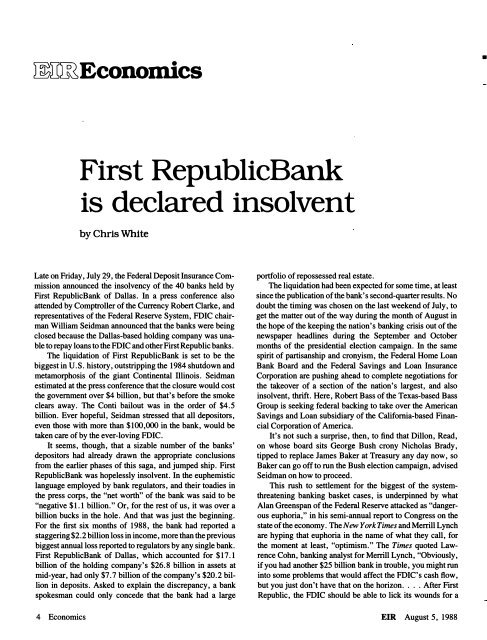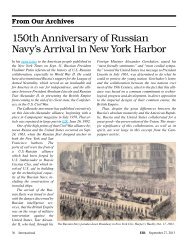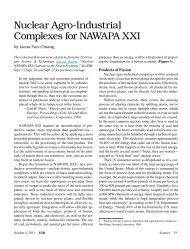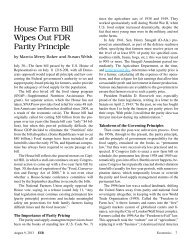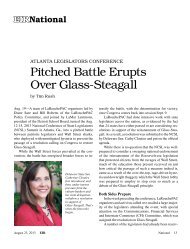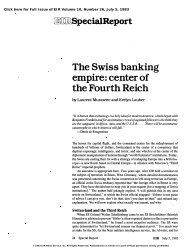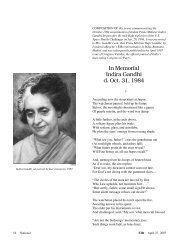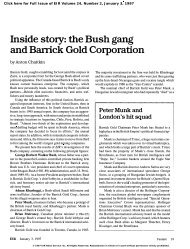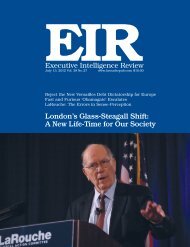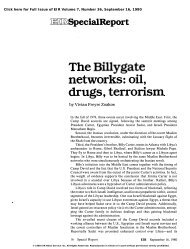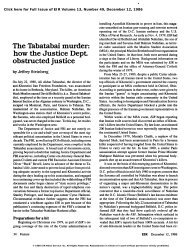View Full Issue - Executive Intelligence Review
View Full Issue - Executive Intelligence Review
View Full Issue - Executive Intelligence Review
You also want an ePaper? Increase the reach of your titles
YUMPU automatically turns print PDFs into web optimized ePapers that Google loves.
�TIrnEconomics<br />
First RepuhlicBank<br />
is declared insolvent<br />
by Chris White<br />
Late on Friday, July 29, the Federal Deposit Insurance Com<br />
mission announced the insolvency of the 40 banks held by<br />
First RepublicBank of Dallas. In a press conference also<br />
attended by Comptroller of the Currency Robert Clarke, and<br />
representatives of the Federal Reserve System, FDIC chair<br />
man William Seidman announced that the banks were being<br />
closed because the Dallas-based holding company was una<br />
ble to repay loans to the FDIC and other First Republic banks.<br />
The liquidation of First RepublicBank is set to be the<br />
biggest in U. S. history, outstripping the 1984 shutdown and<br />
metamorphosis of the giant Continental lllinois. Seidman<br />
estimated at the press conference that the closure would cost<br />
the government over $4 billion, but that's before the smoke<br />
clears away. The Conti bailout was in the order of $4.5<br />
billion. Ever hopeful, Seidman stressed that all depositors,<br />
even those with more than $100,000 in the bank, would be<br />
taken care of by the ever-loving FDIC.<br />
It seems, though, that a sizable number of the banks'<br />
depositors had already drawn the appropriate conclusions<br />
from the earlier phases of this saga, and jumped ship. First<br />
RepublicBank was hopelessly insolvent. In the euphemistic<br />
language employed by bank regulators, and their toadies in<br />
the press corps, the "net worth " of the bank was said to be<br />
"negative $1.1 billion." Or, for the rest of us, it was over a<br />
billion bucks in the hole. And that was just the beginning.<br />
For the first six months of 1988, the bank had reported a<br />
staggering $2.2 billion loss in income, more than the previous<br />
biggest annual loss reported to regulators by any single bank.<br />
First RepublicBank of Dallas, which accounted for $ 17.1<br />
billion of the holding company's $26.8 billion in assets at<br />
mid-year, had only $7.7 billion of the company's $20.2 bil<br />
lion in deposits. Asked to explain the discrepancy, a bank<br />
spokesman could only concede that the bank had a large<br />
4 Economics<br />
portfolio of repossessed real estate.<br />
The liquidation had been expected for some time, at least<br />
since the publication of the bank's second-quarter results. No<br />
doubt the timing was chosen on the last weekend of July, to<br />
get the matter out of the way during the month of August in<br />
the hope of the keeping the nation's banking crisis out of the<br />
newspaper headlines during the September and October<br />
months of the presidential election campaign. In the same<br />
spirit of partisanship and cronyism, the Federal Home Loan<br />
Bank Board and the Federal Savings and Loan Insurance<br />
Corporation are pushing ahead to complete negotiations for<br />
the takeover of a section of the nation's largest, and also<br />
insolvent, thrift. Here, Robert Bass of the Texas-based Bass<br />
Group is seeking federal backing to take over the American<br />
Savings and Loan subsidiary of the California-based Finan<br />
cial Corporation of America.<br />
It's not such a surprise, then, to find that Dillon, Read,<br />
on whose board sits George Bush crony Nicholas Brady,<br />
tipped to replace James Baker at Treasury any day now, so<br />
Baker can go off to run the Bush election campaign, advised<br />
Seidman on how to proceed.<br />
This rush to settlement for the biggest of the system<br />
threatening banking basket cases, is underpinned by what<br />
Alan Greenspan of the Federal Reserve attacked as "danger<br />
ous euphoria," in his semi-annual report to Congress on the<br />
state of the economy. The New York Times and Merrill Lynch<br />
are hyping that euphoria in the name of what they call, for<br />
the moment at least, "optimism." The Times quoted Law<br />
rence Cohn, banking analyst for Merrill Lynch, "Obviously,<br />
if you had another $25 billion bank in trouble, you might run<br />
into some problems that would affect the FDIC's cash flow,<br />
but you just don't have that on the horizon .... After First<br />
Republic, the FDIC should be able to lick its wounds for a<br />
EIR August 5, 1988<br />
•


